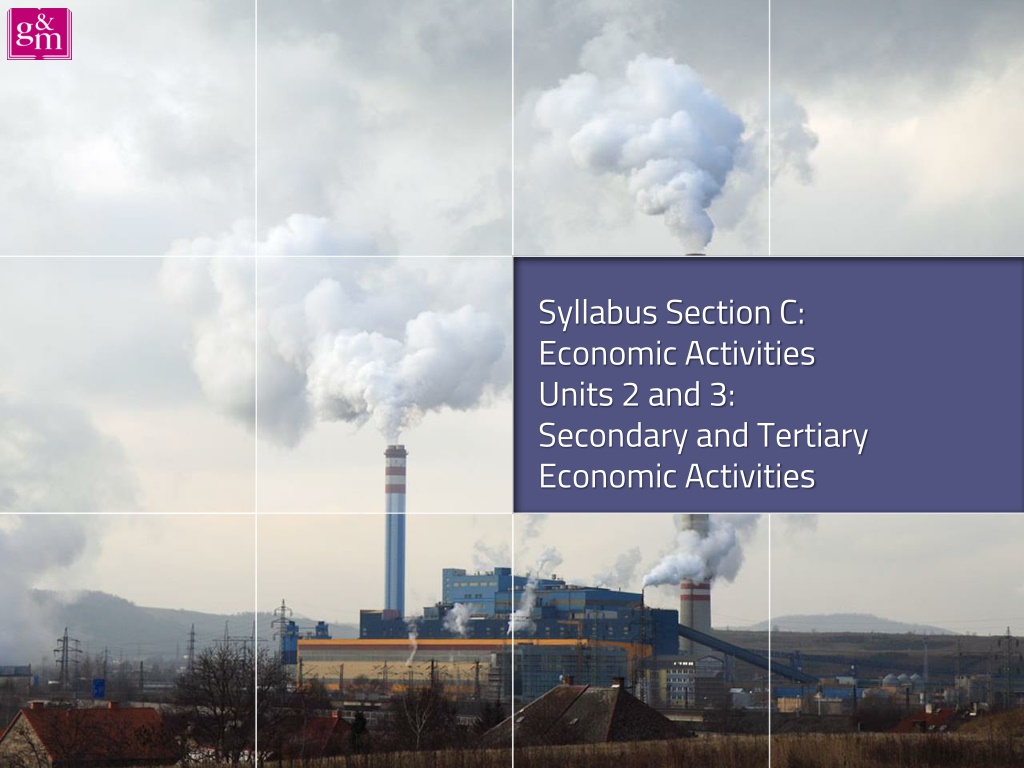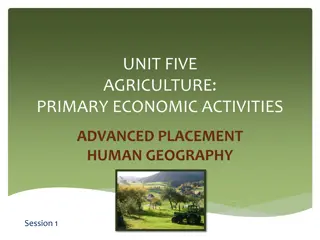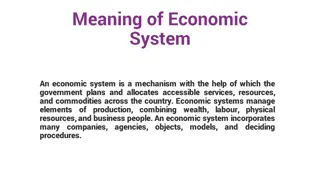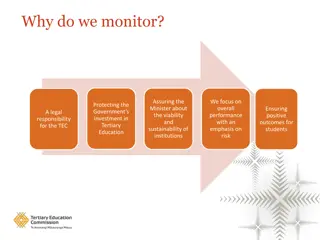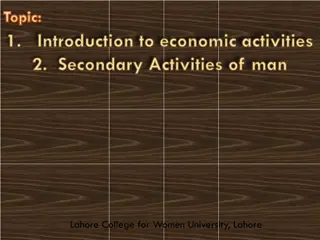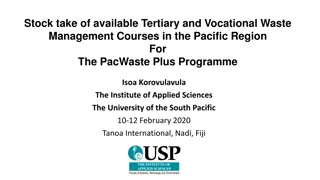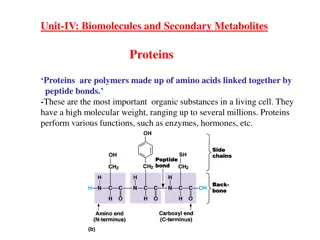Understanding Economic Activities: Secondary and Tertiary Sectors
Exploring secondary economic activities like manufacturing and heavy industries, as well as identifying characteristics of different industries such as light manufacturing. Images and descriptions help clarify concepts.
Download Presentation

Please find below an Image/Link to download the presentation.
The content on the website is provided AS IS for your information and personal use only. It may not be sold, licensed, or shared on other websites without obtaining consent from the author. Download presentation by click this link. If you encounter any issues during the download, it is possible that the publisher has removed the file from their server.
E N D
Presentation Transcript
Syllabus Section C: Economic Activities Units 2 and 3: Secondary and Tertiary Economic Activities
Economic Activities [Question 1/10] What are secondary economic activities? Heavy industry Heavy industry 1 Extractive industry Extractive industry 2 Footloose industry Footloose industry 3 Manufacturing industry Manufacturing industry 4
Economic Activities [Question 1/10] What are secondary economic activities? That s right! Secondary economic activities are those in which people process or manufacture materials. Factories are examples of places of secondary activities.
Economic Activities [Question 1/10] What are secondary economic activities? That s not it. Secondary economic activities are those in which people process or manufacture materials. Factories are examples of places of secondary activities.
Economic Activities [Question 2/10] What type of industry uses large amounts of bulky raw materials? Manufacturing industry Manufacturing industry 1 Footloose industry Footloose industry 2 Heavy industry Heavy industry 3 Light industry Light industry 4
Economic Activities [Question 2/10] What type of industry uses large amounts of bulky raw materials? That s right! Heavy industries use large amounts of bulky raw materials and usually produce big or heavy products in large factories.
Economic Activities [Question 2/10] What type of industry uses large amounts of bulky raw materials? That s not it. Heavy industries use large amounts of bulky raw materials and usually produce big or heavy products in large factories.
Economic Activities [Question 3/10] Which of the following companies is an example of a light manufacturing industry? Intel Intel 1 Bus ireann Bus ireann 2 Bord na M na Bord na M na 3 Irish Cement Ltd Irish Cement Ltd 4
Economic Activities [Question 3/10] Which of the following companies is an example of a light manufacturing industry? That s right! Intel is an example of light industry. Its huge plant at Leixlip uses relatively small quantities of raw materials to make tiny microprocessors.
Economic Activities [Question 3/10] Which of the following companies is an example of a light manufacturing industry? That s not it. Intel is an example of light industry. Its huge plant at Leixlip uses relatively small quantities of raw materials to make tiny microprocessors.
Economic Activities [Question 4/10] Which of the following statements describes footloose industries? Industries that manufacture goods from loose gravel Industries that manufacture goods from loose gravel 1 Industries that specialise in arts and dance Industries that specialise in arts and dance 2 Industries that are not tied to any one location Industries that are not tied to any one location 3 Marine-based industries Marine-based industries 4
Economic Activities [Question 4/10] Which of the following statements describes footloose industries? That s right! Footloose industries are modern industries that are not tied to any one location. They can be situated successfully in a wide variety of places.
Economic Activities [Question 4/10] Which of the following statements describes footloose industries? That s not it. Footloose industries are modern industries that are not tied to any one location. They can be situated successfully in a wide variety of places.
Economic Activities [Question 5/10] Which of the following countries is newly industrialised? Peru Peru 1 China China 2 Ethiopia Ethiopia 3 Germany Germany 4
Economic Activities [Question 5/10] Which of the following countries is newly industrialised? That s right! China is a newly industrialised country. Located mainly in Asia and Latin America, newly industrialised regions enjoy very rapid industrial growth and now contain some of the world s leading industrial countries.
Economic Activities [Question 5/10] Which of the following countries is newly industrialised? That s not it. China is a newly industrialised country. Located mainly in Asia and Latin America, newly industrialised regions enjoy very rapid industrial growth and now contain some of the world s leading industrial countries.
Economic Activities [Question 6/10] What is acid rain? Rainwater with a pH value of less than 5.6 Rainwater with a pH value of less than 5.6 1 Rainwater with a pH value of more than 5.6 Rainwater with a pH value of more than 5.6 2 Rainwater with a very high pH value Rainwater with a very high pH value 3 None of the above None of the above 4
Economic Activities [Question 6/10] What is acid rain? That s right! Rainwater with a pH value of less than 5.6 is considered to be acid rain. The lower the pH value of water, the more acidic it is.
Economic Activities [Question 6/10] What is acid rain? That s not it. Rainwater with a pH value of less than 5.6 is considered to be acid rain. The lower the pH value of water, the more acidic it is.
Economic Activities [Question 7/10] How does acid rain affect soil? It increases the calcium levels. It increases the calcium levels. 1 It increases the alkaline levels. It increases the alkaline levels. 2 It causes severe leaching. It causes severe leaching. 3 It causes severe mass movement. It causes severe mass movement. 4
Economic Activities [Question 7/10] How does acid rain affect soil? That s right! Acid rain causes severe leaching, which washes valuable nutrients such as calcium down beneath the reach of tree and other plant roots. Acidic soils are less able to support farm crops.
Economic Activities [Question 7/10] How does acid rain affect soil? That s not it. Acid rain causes severe leaching, which washes valuable nutrients such as calcium down beneath the reach of tree and other plant roots. Acidic soils are less able to support farm crops.
Economic Activities [Question 8/10] Which of the following describes an industrially emergent region? A region with newer, rapidly growing industry A region with newer, rapidly growing industry 1 A region with long-established industry A region with long-established industry 2 A region with very little industry A region with very little industry 3 Any country in Asia Any country in Asia 4
Economic Activities [Question 8/10] Which of the following describes an industrially emergent region? That s right! An industrially emergent region has very little industry. Most industrially emergent countries are in Africa and South America.
Economic Activities [Question 8/10] Which of the following describes an industrially emergent region? That s not it. An industrially emergent region has very little industry. Most industrially emergent countries are in Africa and South America.
Economic Activities [Question 9/10] Which of the following statements is true? As countries get richer, tertiary activities increase. As countries get richer, tertiary activities increase. 1 As countries get richer, primary activities increase. As countries get richer, primary activities increase. 2 As countries get richer, tertiary activities decline in importance. As countries get richer, tertiary activities decline in importance. 3 As countries get richer, secondary activities become more common than tertiary activities. As countries get richer, secondary activities become more common than tertiary activities. 4
Economic Activities [Question 9/10] Which of the following statements is true? That s right! As countries get richer, tertiary activities increase. This is because richer people can afford to use services such as restaurants, hairdressers, banks, etc.
Economic Activities [Question 9/10] Which of the following statements is true? That s not it. As countries get richer, tertiary activities increase. This is because richer people can afford to use services such as restaurants, hairdressers, banks, etc.
Economic Activities [Question 10/10] Which of the following is an example of a heavy industry? Fishing Fishing 1 Farming Farming 2 Cement making Cement making 3 Harvesting peat Harvesting peat 4
Economic Activities [Question 10/10] Which of the following is an example of a heavy industry? That s right! Cement making is an example of a heavy industry. Other examples include steel making and modern ship building.
Economic Activities [Question 10/10] Which of the following is an example of a heavy industry? That s not it. Cement making is an example of a heavy industry. Other examples include steel making and modern ship building.
Economic Activities Well done! You ve completed the quiz.
